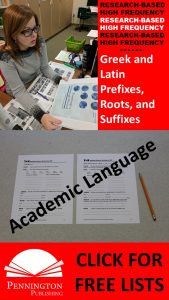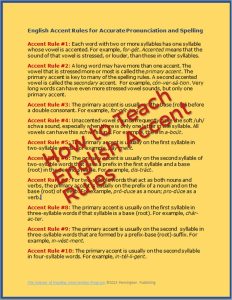Common Core Vocabulary
One quick glance at the Vocabulary Standards (see below) will convince most teachers that the traditional method of vocabulary instruction in our schools: pre-teaching a few challenging words before reading an article or story and handing out a vocabulary word list of Greek and Latin word parts, a few homonyms, the weekly spelling words, and a few hard words to be studied at home and tested on Friday is simply not the vocabulary instruction that the Common Core authors have in mind.
The Common Core State Standards emphasize a balanced approach to vocabulary development. Unlike some of the other ELA Standards, the vocabulary Standards are quite specific. Although much of our Tier 2 (academic language) vocabulary is acquired through reading challenging text, other gateways to vocabulary acquisition are best taught through explicit instruction. Let’s take a look at the Common Core Vocabulary Standards and the key instructional strategies to teach each Standard:
- Multiple Meaning Words and Context Clues (L.4.a.)
- Greek and Latin Word Parts (L.4.a.)
- Language Resources (L.4.c.d.)
- Figures of Speech (L.5.a.)
- Word Relationships (L.5.b.)
- Connotations (L.5.c.)
- Academic Language Words (L.6.0)
Instructional Strategies
Multiple Meaning Words
Students should practice grade-level homonyms (same spelling homographs and sound homophones) in context clue sentences which show the different meanings and function (part of speech) for each word.
Greek and Latin Word Parts
Greek and Latin word parts appear in 50% of our Tier 2 academic words. In choosing which Greek and Latin word parts to teach, teachers should consider three criteria:
- Frequency research
- Utility for grade-level Tier 2 words
- Pairing:
Regarding #s 2 and 3, pairing word parts as Greek or Latin prefix-roots or root-suffix combinations enhances memorization and demonstrates utility of the Greek and Latin word parts. For example, pre (before) is paired with view (to see). Students use these combinations to make educated guesses about the meaning of the whole word. This word analysis is critical to teaching students how to problem-solve the meanings of unknown words.
Check out more on how to teach Greek and Latin word part vocabulary HERE and Greek and Latin word part games and a fantastic list of 15 Power Words which include the paired (and more) word parts HERE.
Language Resources
Students can look up the Greek and Latin pairings as whole words in a dictionary (print or online) to compare and contrast their educated guesses to the denotative definition of the words. Students should divide the vocabulary word into syl/la/bles, mark its primary áccent, list its part of speech, and write its primary definition.
Additionally, students can extend their learning by writing synonyms, antonyms, or inflected forms of the word, using either the dictionary or thesaurus (print or online). This activity helps students develop a more precise understanding of the word.
Figures of Speech
Students should learn a variety of figures of speech (non-literal expression used by a certain group of people). The Common Core Vocabulary Standards assign specific types of figures of speech to each grade level. For example, grade 4 students should learn idioms, similes, metaphors, imagery, adages, alliteration, proverbs, and onomatopoeia. Students should review each of these in grades 5−7 and learn personification, symbolism, colloquialisms, allusions, consonance, assonance, verbal irony, situational irony, dramatic irony, and puns by grade 8. Complexity should increase grade to grade.
Word Relationships
Students must learn not only to recognize context clues to discover the meanings of unknown words in their reading, but also learn how to apply context clues strategies to show the meanings of unfamiliar words and technical terms in their own writing.
Students do so by learning the categories of word relationships. Again, vocabulary instructional programs should increase in complexity from grade to grade. For example, a grade 4 word relationship category of item to category with examples such as hurricane to weather makes sense, By grade 8, students should learn more challenging word relationship categories, such as problem to solution with examples like infection to diagnosis.
Connotations: Shades of Meaning
Students need to be exposed to new grade-level vocabulary words which have similar denotative meanings, but different connotative meanings. From the provided definitions, students write these new words on a semantic spectrum to fit in with two similar words, which most of your students will already know. For example, the two new words, abundant and scarce would fit in with the already known words, plentiful and rare in this semantic order: abundant–plentiful–scarce–rare.
Academic Language
The Common Core authors write a helpful explanation of why Tier 2 words (academic vocabulary) should be the focus of vocabulary instruction. Many of these words will be discovered and learned implicitly or explicitly in the context of challenging reading, using appropriately leveled independent reading, such as grade-level class novels and specific reading strategies, such as close reading with shorter, focused text. Establishing an instructional scope and sequence of these Tier 2 words with grade-level, below, and above teaching colleagues is critical to non-repetitive curricular mapping from grade to grade level.
Additionally, direct instruction of high utility and high frequency academic vocabulary is certainly worthwhile. Teachers may wish to check out the research-based Academic Word List. Students can use the four square (definition, synonym, antonym, and example-characteristic-picture) Frayer model to learn these words. The Common Core authors and reading specialists (like me) refer to this process as learning vocabulary with depth of instruction.
If you are looking for a program to teach each of the Common Core Vocabulary Standards for your grade level, the author provides several program options. Each option includes vocabulary worksheets as described above to teach the grade-level Vocabulary Standards (L.4, 5, 6).
The Vocabulary Academic Literacy Center in available in grades 4, 5, 6, 7, and 8 program levels. For teachers, opting for a non-literacy center approach to vocabulary instruction, the same resources (and more) are included in the author’s grades 4–8 Common Core Vocabulary Toolkits and in the grades 4–8 Grammar, Mechanics, Spelling, and Vocabulary BUNDLES.
PREVIEW THE GRADE 4 VOCABULARY WORKSHEETS HERE.
PREVIEW THE GRADE 5 VOCABULARY WORKSHEETS HERE.
PREVIEW THE GRADE 6 VOCABULARY WORKSHEETS HERE.
PREVIEW THE GRADE 7 VOCABULARY WORKSHEETS HERE.
PREVIEW THE GRADE 8 VOCABULARY WORKHEETS HERE.






